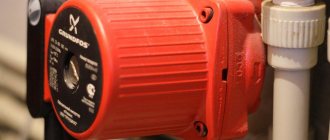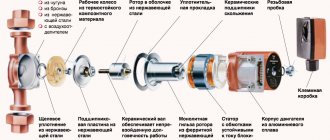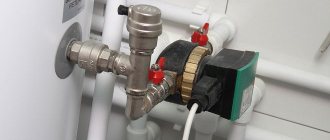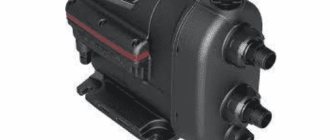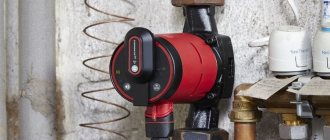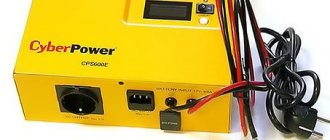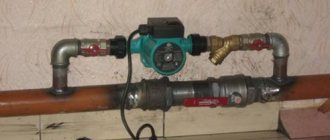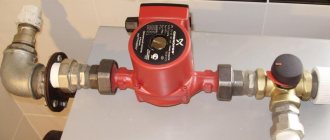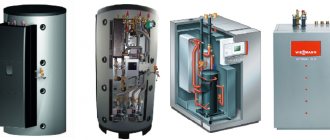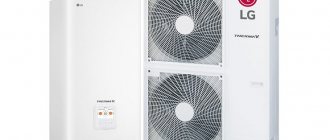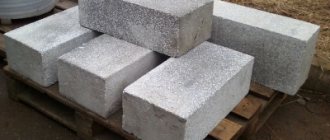Frequent power outages are very dangerous for a closed heating system. After uneven heating, the pressure in the pipes increases, the hot coolant from the boiler moves slowly, which leads to uneven heating of the rooms. An uninterruptible power supply for a heating pump, then a UPS, allows you to get rid of all these problems, because a certain supply of electricity will accumulate in the specified device, which will allow you to maintain the operating condition of the circulation pump during a power outage.
Uninterruptible power supplies for circulation pumps
Here you will learn:
- Structure of heating systems
- What is an uninterruptible power supply?
- Types of uninterruptible power supplies
- How to choose an uninterruptible power supply
- How to make an uninterruptible power supply for a heating pump with your own hands
- Factory models
The use of heating systems with forced circulation of coolant forces us to consider providing backup power for the pumps used in them. Otherwise, cutting off the power will cause the circuit to stop. For power backup, an uninterruptible power supply is required for the heating pump. Using charged batteries, it will provide the pumping unit with alternating current at the required voltage.
It is this equipment that will be discussed in our review. Such devices are manufactured in conjunction with an off-line switch and a voltage regulator that operates in automatic mode. The main advantage of this uninterruptible power supply is the ability to ensure normal operation of the circulation pump when the voltage in the electrical network increases or decreases. The downside of the UPS in question is the certain period of time for switching to the battery during power outages.
Linear-interactive uninterruptible power supply for heating is one of the options for ensuring the safety of the heating system
The efficiency of such devices occupies an intermediate position between simple and cheap off-line UPSs and expensive high-quality devices with on-line double voltage conversion. In practice, line-interactive uninterruptible power supplies are used for continuous operation of desktop computers and monitors, circulation pumps and other devices.
According to the method of obtaining the voltage at the output of the battery, such devices are divided into two main types:
- Voltage generation using a pure sinusoid. Such installations are often used as an alternative to double voltage conversion;
- Obtaining voltage from an approximated sinusoid. Such UPSs are operated in conjunction with a personal computer.
Linear (on-line)
Such intelligent equipment is characterized by double conversion of electricity online. Thanks to these features of the device, voltage surges in the network are leveled out and frequency balance is established. The supply voltage of the heating pump is always stable, 220 volts, which helps to extend the service life of the described device.
Note! This type of UPS quickly turns on the pump during power outages. This is possible through double voltage conversion in the network.
Types of UPS
The uninterruptible power supply, depending on the supported options, performs the following functions:
- automatic switching to power from a rechargeable battery (AB) in emergency situations;
- inverting DC voltage (12 V) into the required alternating voltage (220 V) with frequency adjustment of 50 Hz;
- smoothing out voltage surges and filtering network noise lasting 10–100 ms;
- stabilization of the “transit” network voltage in normal mode.
Reference! Switching the power supply of the heating pump to the battery, converting voltage and filtering network noise are performed by all UPS/UPS. Voltage stabilization is carried out only by devices equipped with a stabilizer unit.
There are three types of uninterruptible power supplies, which are also used to work with circulation pumps in heating systems.
Reserve
The simplest budget models provide only a transition to backup power. In normal mode, the mains voltage goes directly to the boiler without stabilization , passing through one passive surge noise protection filter.
Photo 1. A budget backup uninterruptible power supply can only provide a transition to backup power.
If the network power is turned off or the parameters go beyond the range values, the switch connects the standard battery within 4–12 ms. The DC voltage of the battery is first supplied to the electrical converter, where it becomes alternating and then increases to the required 220 V.
Nuances of assembling an external harmonic filter
And the so-called harmonious system for voltage filters will help us with this.
Here too, you can take the initiative and do it yourself, but it’s better to at least install and find a proven scheme first. Such filters consist of various resistors, transformers and other auxiliary devices.
A properly assembled system should be guaranteed to stabilize any source of electric current.
However, the circuit of such a filter is simple; it can be seen below.
The main difficulty here lies in calculating the parameters. The circuit elements are calculated and made identically, only they are assembled in different ways - one is serial, the other is parallel, but in both cases they are tuned to a frequency of 50 Hz.
It is necessary to calculate the parameters of the inductors for the available core.
You will also need to make a gap between the turns in the core.
The formulas for calculating the parameters are as follows:
- Clearance in millimeters = 1.257E-3 * max. current in amperes * number of turns.
- Number of turns = 1.257E6 * max. current in amperes * inductance of the inductor in H * cross-sectional area of the core in square millimeters - round the result up
- For a series circuit: the maximum current in amperes is 1.4 * {load power, W} / 220 V.
- For a parallel circuit: the maximum current in amperes is 1.4 * 220 V / 28 * {signal frequency, Hz - 50 Hz} * { inductance of the inductor, H}.
How to choose an uninterruptible power supply for a heating pump?
When purchasing an emergency power supply, take into account the power, battery life, the possibility of introducing additional batteries, and the transition time to battery operation.
Selection by type
Double conversion UPSs have the most suitable characteristics for powering heating equipment. They provide a stable voltage, smooth out fluctuations, and block high-frequency interference. Inverter uninterruptible power supplies support the operation of boilers equipped with complex electronic modules.
The only drawback is the increased noise level emitted by the coolers.
Linear UPSs are low cost. Such devices do not stabilize the voltage supplied from the network. A sudden change in current parameters can damage heating equipment. However, linear sources have the highest efficiency.
Uninterruptible power supply units for heating pump
Externally, the device resembles a large system unit. Often the front panel has a display with a clock and a panel with buttons. Intuitive controls - all basic data is displayed on the screen: input and output voltage, battery charge level, current strength and others.
The essence of its work is to accumulate energy in batteries and then release it when necessary.
Connecting an uninterruptible power supply to the heating system
- uninterruptible power supply unit;
- 12 V battery(s).
The voltage of 220 V is converted to 12 V and supplied to the charger. At the same time, energy feeds the boiler from the network. When the battery(s) are fully charged, the current supply is automatically stopped, i.e. it continues to arrive, but in transit.
If the network is turned off, the UPS begins the reverse conversion - constant from 12 V batteries to alternating 220 V.
Operating principle of an uninterruptible power supply
The automation will automatically turn on the backup power supply, and when the power supply is restored, it will switch to operation from the network. No human intervention is required to charge the batteries. It works silently.
Most often, batteries made using AGM technology or with gel electrolyte are used. Connect them in series. All end bends and jumper cables are included.
There is one caveat - the UPS takes longer to charge than it discharges. Therefore, an uninterruptible power supply for a circulation pump will not be able to completely replace the power plant for a long time.
The need for a UPS
In addition to the situations already listed (power outages and power surges), a UPS is also useful when the energy source is an air-cooled generator - diesel or gasoline.
The voltage produced from it has a sawtooth output when a pure sine wave is required. A double conversion UPS installed between the boiler and the generator solves the problem.
So, here is a list of requirements for a UPS:
- voltage stabilization;
- possibility of long-term operation without external power supply;
- voltage supply in the form of a smooth sinusoid;
- frequency accuracy;
- smooth and instant transition to batteries;
- reliability.
Read about the installation of heated floors and energy costs for heating here.
Is it possible to replace the UPS with a computer uninterruptible power supply or use a car battery?
No. Computer UPSs have output voltage in the form of teeth - rectangles. They overheat the circulation pumps.
Popular factory models
You can choose the right UPS both in online stores and in specialized super markets that sell accessories for heating equipment or plumbing. The choice is of course yours. And we will give only some popular models and their approximate cost.
Energy PN-1000
Energy PN-1000 is a fairly powerful device that is capable of providing uninterrupted power supply for boiler appliances. Recommended for use in a set with 100 A/h batteries. Designed to work with low-power (150 W) pumps. This device can last 9 hours offline. With a smooth sinusoid type output signal. There is a pre-installed network interference filter. For informational purposes, the front panel is equipped with a display. With a fairly high efficiency, the price for this model is 26,100 rubles.
SVC DI-600-F-LCD
Designed to support the operation of boilers and pumping stations in autonomous mode. The response speed is 15 microseconds. When using external storage units with a capacity of up to 200 A/h, the pump will operate continuously for up to 24 hours. The peak load on the uninterruptible power supply is no more than 360 W. Does not require systematic maintenance. This modification will cost about 7 thousand rubles.
Tieber T-1000
Tieber T-1000 can maintain the operation of the heating system for at least 48 hours in the event of a centralized power supply interruption. For operation, it is recommended to use a pair of gel batteries, each with a capacity of 200 Ah. Withstands peak loads up to 800 W. The output waveform is a pure sine wave. Price - 15,100 rubles.
Operating principle and design of the UPS
The emergency power source, depending on the design, can perform the following functions:
- Automatic switching to battery power;
- Converting DC voltage 12V to AC 220V;
- Network interference filtering;
- Mains voltage stabilization.
The transfer of power from the circulation pump to the battery, voltage inversion and filtering from impulse noise are performed by all UPSs, and stabilization is carried out only by devices equipped with the appropriate unit.
Domestic UPS. A large assortment of inverter uninterruptible power supplies for boilers and heating pumps is presented by domestic manufacturers, positive reviews of whose products you can easily find on the Internet. You can get acquainted with the company's products on the website of the official representative of Energia.ru.
The following models of emergency power supplies can be used in power supply systems:
- Backup UPS;
- Linear interactive;
- Double inverting UPS.
Reserve
Emergency sources under normal conditions provide power to the consumer directly from the network, and when it is turned off, they automatically switch to the battery. The DC voltage from the battery is first supplied to a voltage converter, where it becomes alternating and rises to 220 volts. The mains voltage is not stabilized, and to block mains impulse noise, the device uses a passive filter.
Linear interactive
The linear-interactive backup power supply has one significant difference. It uses a simple stabilizer to equalize the network voltage. It is made according to a circuit using an autotransformer, where when the input voltage changes, an electronic switch connects the corresponding windings. The stabilization circuit allows you to obtain an output voltage that is only slightly different from the nominal one. A voltage converter and filter are also included in this device.
Inverter
A power supply using double inversion is a design that is fundamentally different from the previous two.
In this device, the mains voltage is rectified, while part of the energy is stored in a battery of capacitors. In the second inverter, secondary conversion of direct current to alternating current occurs. Capacitors serve double duty. If the voltage is too high, then its excess is stored in them, and if the voltage decreases, the shortage is replenished with accumulated energy.
Causes
The pressure in the system is to blame: with natural circulation it does not exceed 0.6 mPa, and this is not enough to provide heating for a multi-story or just a large building. To increase pressure and improve water circulation, you need to either create a closed system using larger diameter pipes, or build in a circulation pump.
Since reconstruction using larger diameter pipes is not a cheap procedure, the best solution in this case is a circulation pump.
How to connect a UPS
There are rarely any problems connecting modern UPSs. They are equipped with inputs and all the necessary wires; it is only important to follow the correct connection order.
The sequence of actions is as follows:
- Read the instructions carefully and check that all wires are present.
- If the design provides external power sources, connect them with wires to the device.
- Choose a place for the UPS: the device should be out of reach of children and animals, but close to the batteries.
- Connect the uninterruptible power supply to the pump, and if necessary, to a gas or solid fuel heating boiler.
- Connect the UPS to the network (there is no need to connect the batteries to the network) and check the operation of the equipment.
In order for the device to work correctly, you must follow certain rules when installing it:
- The temperature in the room must correspond to that specified in the instructions. Operating the device at high and low temperatures leads to a decrease in battery life.
- Installation of the ground loop should be carried out in accordance with the operating rules for electrical equipment.
- It is prohibited to install the UPS in places where there are vapors of flammable liquids and caustic substances.
What to look for?
Most modern heating systems use methane as fuel. But for the system to operate stably, it must have a current source that produces continuous voltage without any interruptions. If the power supply is abruptly turned off, the coolants will gradually cool down, and this is very unpleasant, since cracks may eventually appear on them in some places - first small, and then larger.
Therefore, carefully monitor the stability of the device!
Parameters taken into account when choosing an uninterruptible power supply for a heating pump
The following pump parameters must be taken into account:
- rated power,
- starting power (power consumed at the moment it is turned on),
- desired battery life (estimated time without mains power supply).
The rated power is quite easy to determine - it is always in the technical documentation for the pump, and you can simply navigate by the required autonomy time - this is the duration of the power outage in your area plus some reserve time just in case. Both of these parameters will affect the capacity, and therefore the cost, of the batteries connected to the UPS.
The choice of uninterruptible power supply depends on the starting power; it determines the required power of the device. Most manufacturers do not indicate this characteristic in the documentation, so we determine it based on the energy efficiency class.
If the pump has class A, we calculate the starting power with a factor of 1.3 from the rated one. If the energy efficiency class is lower or unknown, we apply a factor of 5 . If you ignore the pump’s starting mode, the power required to turn it on will be greater than the power of the UPS, even taking into account its overload capabilities, and this will lead to its shutdown “due to overload.”
Installation
The procedure for installing a UPS with an inverter depends directly on the device model. The difference between such 12/220 voltage converters lies in the type of automation, which determines the installation process.
Thus, some units are mounted directly on the motor of pumping equipment. Another type of uninterruptible power supply is wall-mounted only and only operates in a vertical position. There is also an uninterruptible power supply of rectangular shape and impressive size. This type of automation is installed next to the circulation device. You can connect the 12/220 voltage converter yourself, using the instructions.
Solutions
You can get around the problem of power outages by simply installing larger diameter pipes into the existing system. The liquid in this system circulates naturally - due to the force of gravity. However, such a system is not convenient to regulate.
You can also use a generator. However, the generator requires special operating conditions: maintaining the same fuel level and having a special place. All this, as a rule, requires finance, and besides, it is unsafe. During operation, there is a possibility of power surges, which can lead to breakdown of the electronic control system of the boiler.
It is much more convenient and easier to solve the issue using a UPS - an uninterruptible power supply. “Uninterruptible power supply” automatically turns on when there is no power, so the system will work in any case. UPS equipment can be installed in any room without any special maintenance - the batteries are replaced every 2-3 years. This device operates almost silently. It should also be noted that installing a UPS is much cheaper than buying, for example, a generator.

